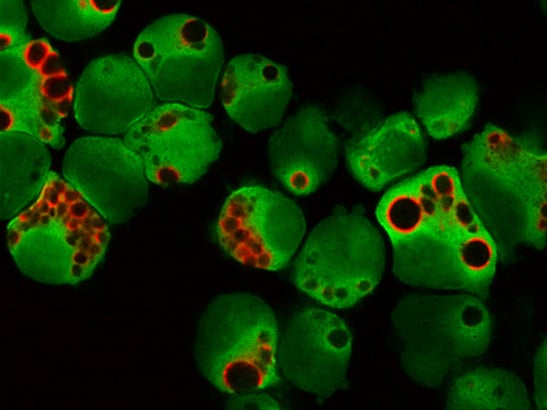
Image: Immunofluorescent image of autophagosomes (red) in multiple myeloma cells stained with acridine orange following treatment with a PI3K inhibitor. Credit: Lauren Aronson, ICR
A new genetic test could help doctors pick out patients with the bone marrow cancer multiple myeloma who are at ‘ultra high risk’ of their cancer progressing aggressively early on.
Researchers showed that patients whose cancers display particular genetic patterns have a much poorer survival than average and are unlikely to benefit from a drug called lenalidomide on its own.
Picking out patients whose cancers have high-risk genetic features could therefore help clinicians realise sooner if they’re unlikely to respond to treatment, enabling them to find alternative options as early as possible.
Scientists at The Institute of Cancer Research, London, studied 329 patients across UK hospitals from the phase III Cancer Research UK Myeloma XI trial, which looked at the effectiveness of a range of targeted drugs, including lenalidomide, in people with newly diagnosed with multiple myeloma.
Their study is published in Leukemia and was funded by Myeloma UK and the NIHR Biomedical Research Centre at The Royal Marsden NHS Foundation Trust and The Institute of Cancer Research (ICR), with further support from Cancer Research UK and through the Jacquelin Forbes-Nixon Fellowship.
Patterns of abnormal gene activity
Researchers looked for people at ultra high risk by analysing patterns of abnormal gene activity and genetic mutations of their cancers – with the aim of finding out if these ‘signatures’ could provide clues as to how aggressive their cancer is, how quickly it spreads and if it is likely to respond to treatment with lenalidomide on its own.
One quarter of the patients, 81 in total, had cancers with the so-called SKY92 signature – a pattern of gene activity involving 92 genes linked to high risk status.
On average patients with cancers that had the SKY92 high-risk gene expression signature had an up to a three-fold increased risk of their cancer returning early. Those with heavily genetically mutated, so called ‘double-hit’ cancers had a two-fold increased risk of death.
Combining information about these two risk features, which had before been regarded as an ‘either or’ test, improved the researchers’ ability to predict disease outcome.
We are now poised to outsmart cancer with the world’s first anti-evolution 'Darwinian' drug discovery programme, in which we will focus on understanding, anticipating and overcoming cancer evolution, and preventing drug resistance.
11-fold increased risk of death
Around 10 per cent of the total patient group had both the SKY92 signature and double-hit genetic features. People in this group were at ultra high risk of early, aggressive disease relapse, with all cancers in this group progressing within four years with current standard therapies – as opposed to much longer responses in other groups.
Patients with ultra high risk disease had an 11-fold increased risk of death compared with other patients.
The ICR researchers found that patients in this ultra high risk group were highly unlikely to benefit from lenalidomide as ongoing or maintenance therapy – a treatment that can help very efficiently to keep myeloma from coming back after it has responded to initial therapy in cancers with only few or no genetic high risk features.
People with ultra high risk myeloma have a high unmet need for new treatment approaches, including cocktails of novel immunotherapy drugs in combination with chemotherapy. The researchers will be testing different drug combinations in a new clinical trial, OPTIMUM.
Next, the researchers plan to combine the insights from this study with the ongoing OPTIMUM trial, which will look at 470 patients, in order to find alternative treatment options for people with high-risk myeloma.
'Not all patients with myeloma are the same'
Study leader Dr Martin Kaiser, Team Leader in Myeloma Molecular Therapy at The Institute of Cancer Research, London, and Consultant Haematologist at The Royal Marsden NHS Foundation Trust, said:
“Our study shows that people whose cancers have an ‘ultra high risk’ combination of genetic features have particularly aggressive disease which doesn’t respond sufficiently to standard treatment to keep their cancer at bay.
“Testing for high-risk genetic features could help target myeloma treatment, focusing on the specific needs of each patient. Not all patients with myeloma are the same, and we know that by better understanding their cancer’s genetic and molecular features, we can tailor their treatment much more effectively.
“The next step is to combine our results for this study with the ongoing OPTIMUM trial, which will provide us with more information on how to tailor treatment for patients at ultra high risk based on genetic information.”
Personalising treatment
Professor Paul Workman, Chief Executive of The Institute of Cancer Research, London, said:
“This exciting new research shows how it is possible to use genetic information to divide patients with bone marrow cancer into different disease sub-types, and to plan treatment accordingly.
“It will be exciting to see whether targeting these highest-risk patients with an intensive new treatment can improve survival.”
Sarah McDonald, Director of Research at Myeloma UK, said:
“We are aware that myeloma isn’t a ‘one size fits all’ cancer and treatment needs to become more personalised. This paper on the innovative research undertaken by the ICR team is a huge step forward.
“The ability to identify high-risk patients means they can receive the intensive treatment they need sooner and enables further study of this cohort to develop new treatment approaches which can improve patient survival.”
